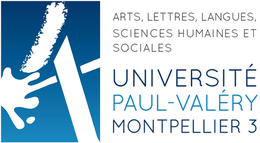Paul Valéry University, Montpellier III
| Université Paul-Valéry Montpellier | |
|
UPVM's logo | |
| Type | Public university |
|---|---|
| Established | 1289/1970 |
| President | Anne Fraïsse |
Academic staff | 627 |
| Students | 19794[1] |
| Location |
Montpellier, Béziers, France Coordinates: 43°37′59″N 3°52′12″E / 43.633°N 3.870°E |
| Campus | Urban |
| Athletics | Service Universitaire des Activités Physiques et Sportives (SUAPS) |
| Affiliations | Coimbra Group |
| Website | univ-montp3.fr |
Paul Valéry University of Montpellier (French: Université Paul-Valéry Montpellier III), also known as or UPVM (official acronym) or Montpellier III (UM3, until early 2015), is a French university in the Academy of Montpellier. It is one of the three successor universities to the University of Montpellier, specialising in the arts, languages and social sciences.
The university is a member of the Coimbra Group, an association of long-established European multidisciplinary universities of high international standard.[2]
History

Paul Valéry is one of the oldest universities in Europe. The University of Montpellier, founded on 26 October 1289 through a bull issued by Pope Nicholas IV combining the schools of Medicine, Arts and Law, is the third university founded in France, following those of Paris and Toulouse.
In 1939, the new Faculty of Humanities was built in the city centre, facing Saint Paul's Cathedral on the rue du Cardinal de Cabrières (currently home to part of the University of Montpellier 1's Law Faculty), and inaugurated by the then Dean Augustin Fliche.
Having become too cramped, the university moved in 1966 to a campus of over 10 hectares in the north of the city (route de Mende), close to the University of Montpellier II's new campus. In order to avoid confusion with the University of Montpellier 2, the architectural aesthetic was very carefully selected and large green spaces created.
In 1970, the former faculties formed three separate universities (Montpellier I, II and III). The Faculty of Arts, Languages, Social Sciences and Humanities becoming the "University of Montpellier III", whilst also taking on the name of Paul Valéry as a homage to the Sète-born writer who studied in Montpellier.
In 1986 a new building comprising three lecture theatres (one seating 800 students) was built.
In 1998, a second University campus was built in Béziers on the site of the former Duguesclin barracks.
Since 2002, all Nîmes students have been included in the University of Nîmes and are no longer part of the University of Montpellier III.
In 2015, the Universities of Montpellier I and II merged to be the University of Montpellier, Therefore, the University Paul Valéry of Montpellier III became University Paul-Valéry of Montpellier (UPVM)
A move of the University's UFR 5 (psychology and sociology department) is currently being planned to the Saint-Charles site in Montpellier city centre.
| Year of appointment | Name | Position | Discipline |
|---|---|---|---|
| 1990 | Jules Maurin | University Professor | Contemporary History |
| 1995 | Pierre Benedetto | University Professor | Psychology |
| 1998 | Michèle Weil | University Professor | Literature |
| 2003 | Jean-Marie Miossec | University Professor | Geography |
| 2008 | Anne Fraïsse | University Professor | Latin |
Notable Alumni
- Ahmad Kamyabi Mask, professor emeritus of comparative literature and theatrical studies
- Élisabeth Guigou, French socialist politician
Student life
Student life is coordinated through the Maison des Étudiants, a place for students' activities, freedom of expression, clubs and societies.
Its aim is to help students realise their own ambitions, allowing them to open up and develop a place for creation, as well as cultural and campus activities.
The Maison des Étudiants and its "Jean Moulin" function room are an important centre for student life on campus, playing host to: dance, music, theatre and first aid classes, as well as conferences, film screenings, debates, exhibitions, solidarity and cultural days, concerts and student evenings, amongst others.
Representative student organisations
Following the student elections of 30 and 31 May 2006 (postponed due to the anti-CPE blockades in March) marked by a low level of participation of around 5% (but a strong one from the Béziers campus of nearly 20%), the representative student organisations are as follows:
- Tribune Étudiante, Confédération étudiante, Avis Culturel : 4 elected to the CA, 4 elected to the CEVU
- UNEF : 3 elected to the CA, 3 elected to the CEVU
- Sud étudiant : 3 elected to the CA, 3 elected to the CEVU
- Melting-Pot : 2 elected to the CA, 2 elected to the CEVU, 1 elected to the CS
- Caraïbe Afrique Solidarité Étudiante (The CASE) : 1 elected to the CA, 1 elected to the CEVU
- Corpo Lettres Epsylone : 1 elected to the CA, 1 elected to the CEVU
- UNI : 1 elected to the CA, 1 elected to the CEVU
- La liste Culturelle étudiante : 1 elected to the CEVU
- Association Contact : 1 elected to the CS
- Étudiants solidaires : 1 elected to the CS
- Réseau doctorant UPV : 1 elected to the CS
Other active associations
All student associations do not inevitably participate in representative student elections but are not less active. Numerous cultural associations, such as Asso7, ECUME or l'Écran et son Double, actively participate in campus activities.
The associations and student unions are housed in the "Maison des Etudiants", found on the north side of campus near the Vert Bois university restaurant.
See also
| Wikimedia Commons has media related to Université Montpellier. |
References
- ↑ http://www.univ-montp3.fr/index.php?option=com_content&view=article&id=20:luniversitn-chiffres&catid=17&Itemid=38
- ↑ Service des Relations Internationales
